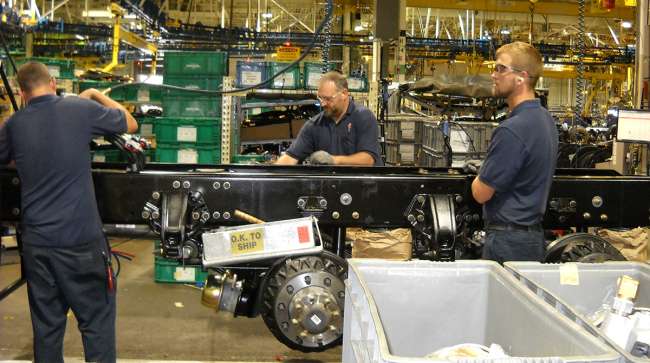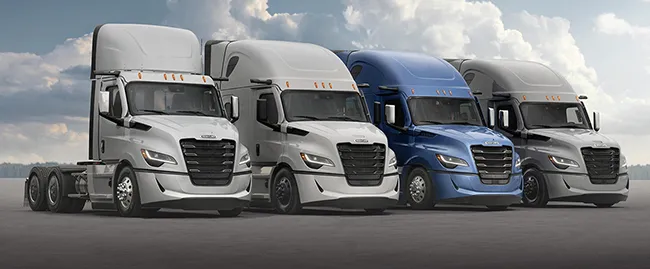Staff Reporter
Truckload Turnaround, Pre-Buy to Boost 2025 Sales, OEMs Say

[Stay on top of transportation news: Get TTNews in your inbox.]
Truck makers are becoming more optimistic about the prospects for 2025 Class 8 purchases, largely as a result of an anticipated turnaround in truckload sector fortunes and expectations that carriers will add equipment before another round of emissions regulations take effect for 2027 model-year trucks.
Class 8 retail sales in the U.S. through the first three quarters of 2024 were underpinned by strong vocational demand, but executives at Paccar Inc. and Volvo Group said during recent third-quarter earnings calls they expect an upturn from the on-highway market in the coming months. The on-highway segment accounts for roughly 80% of Class 8 sales.
Kenworth and Peterbilt parent company Paccar sold 25,900 trucks in the U.S. and Canada in third quarter of 2024, a decrease of 5.8% from 27,500 vehicles in the year-ago period.
“Strong infrastructure spending in the U.S. has been good for Kenworth and Peterbilt’s business due to our market share leadership in vocational trucks,” Senior Vice President Kevin Baney said during an Oct. 22 call with investors and analysts. “The less-than-truckload segment is also performing well, while the truckload segment remains soft.”

Baney
However, Baney’s boss expects a truckload sector revival in the coming months.
“Because of the place [truckload players are] in, there is some price-cost tension, but I think there will be some relief in 2025,” Paccar CEO Preston Feight said. “We’ll see an increase in truckload purchases throughout the year.”
Feight noted that timing will depend on business conditions. “We’re going to see some improvements in the freight market,” he predicted, which will in turn boost purchasing. Paccar estimates 2024 U.S. and Canadian Class 8 retail sales will be in a range of 250,000 to 270,000 vehicles. The company expects retail sales in 2025 to be between 250,000 and 280,000 vehicles.
Over at Volvo Group — parent company of Volvo Trucks North America and Mack Trucks — Feight’s counterpart Martin Lundstedt is even more optimistic about sales levels.

Feight
“We are guiding for … 290,000 this year and 300,000 next year,” he said. “That is primarily driven, as we see it now, by a back-loaded ’25; not heavily back-loaded, 290 to 300, but still a little bit back-loaded.”
The back-loading, he said, would be propelled by upcoming Environmental Protection Agency regulations, specifically, the Phase 3 greenhouse gas rule. It requires truck makers to convert an increasing percentage of their sales to electric vehicles for model years 2027 through 2032.
American Trucking Associations’ Technology & Maintenance Council conducted three surveys during the late spring and summer months, with two involving the impacts of the Phase 3 rule.
The results indicated that the regulations are likely to impact capital expenditures in the procurement of Class 8 vehicles, where a significant percentage of the responding fleets indicated that they would pursue either a pre-buy, a low-buy or combination strategy.
In the meantime, weak freight conditions have inhibited on-highway truck purchases.
Volvo Group’s North American deliveries fell 20% year on year to 12,026 vehicles in Q3 from 15,041 trucks, although this was partly due to supply chain issues at Mack.

Freightliner unveiled its fifth-generation Freightliner Cascadia in October. (Daimler Truck North America)
VTNA truck deliveries in North America for Q3 fell 12% year over year to 6,744 from 7,640 units, while Mack deliveries fell 28% to 5,261 from 7,338 in the same period a year earlier.
The Gothenburg-based parent company is looking to boost Mack’s sales by buying Commercial Vehicle Group’s Kings Mountain, N.C., cab assembly operations to right what Lundstedt called a “tricky situation” slowing deliveries.
“This is super important for Mack, given the fact that we have more customers, we have more volumes out there than we — for quite some time now — have been able to execute for Mack. Mack has such a strong position. And is deserving more when it comes to the market sales,” he added.
“The good news is that we are well into ’25 already for vocational, and there we have a good view on price, execution, etc.,” said Lundstedt.
Paccar is also readying for an upturn in sales, said Feight. “We have all the capacity we will need in the coming year,” he said. “We will not be capacity constrained.”
In addition, Feight said the U.S. presidential election would not impact fleets’ purchasing patterns, noting that an increase in freight rates was far more important to carrier executives than what happened at the polls in November.
Want more news? Listen to today's daily briefing above or go here for more info
The ongoing normalization of interest rates is also set to boost truck sales, said Lundstedt. The Federal Reserve in September cut its benchmark interest rate by 0.5% and indications are growing that further rate cuts may take place.
Lower interest rates will help with both new and used retail sales, as Feight expects prices for both to increase.
Part of that is because truck makers are upgrading their flagship on-highway tractors.
VTNA unveiled its revamped Volvo VNL in January and Freightliner pulled back the curtain on a fifth-generation Cascadia midway through October. Series production of the VNL began in October.




